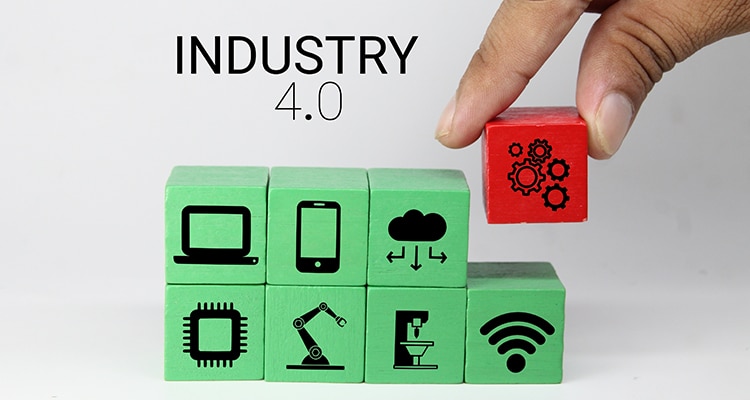The manufacturing sector is racing toward digital transformation.
Termed Industry 4.0, these Factories of the Future seek to limit unplanned maintenance, risk, and hazardous chemical operations by consuming and analyzing Big Data from the Internet of Things (IoT) sensors, Enterprise Resource Planning (ERP) platforms, and chemical inventory Environmental, Health & Safety (EH&S) software.
Fragile supply chains, aging workforces, regulatory pressures, intense competition, and recent black swan events like COVID-19 are forcing large enterprises to leverage technology, particularly Big Data, in optimizing plant operations.
Maintaining safe chemical operations is paramount in this approach as engineering leadership teams move to make the plant more modular and ‘intelligent’ using a wide range of asset optimization technologies.
Building Value With EMS under Industry 4.0
Until recently, most of the emphasis has been on collecting data from the ‘edge,’ including sensors and historians, and bridging the divide between operational technology (O.T.) and traditional (I.T.) to improve process safety under Industry 4.0.
However, combining this production data with operational data from enterprise solutions like Chemical Safety’s Environmental Management Systems (EMS) and ERP platforms like SAP or PeopleSoft can create an even higher value. Achieved via Application Programming Interfaces (API), these software gateways promote open architectures and sharing between cloud platforms.
The end goal is even higher visibility and insight from previously siloed information.
Chemical inventory management and associated Safety Data Sheets (SDS), classifying items as hazardous or non-hazardous, will become key data points in Smart Manufacturing, especially for enterprise customers moving toward a Zero Harm Workplace.
It is, in essence, the “safety node” in a larger ecosystem of connected devices, workers, and software platforms that make up Industry 4.0.
The Emergence of EMS 4.0 and EH&S 4.0
Due to its increased importance in overall plant safety under Industry 4.0, many refer to the latest versions of EMS software platforms as Environmental, Health & Safety 4.0 or EH&S 4.0, or EMS 4.0.
These cloud-based chemical inventory software packages will be critical to the success of future self-optimizing plants.
Chemical spills, incompatible chemical mixing, emissions, and explosions are often associated with plant efficiencies, including sudden equipment failures. Historically, halting production due to an emergency failure has proven to be more dangerous (and expensive) than scheduled manufacturing downtime. Any emergency “hot work” done near the vicinity of stored hazardous chemicals poses a threat (especially if not adequately identified in a standard Hazard Communication Program).
A recent study suggests that unplanned downtime or outages lasting up to four hours cost manufacturers an estimated two million dollars. At least 82% of companies have experienced unplanned downtime in the last year.8 Any related worker injuries, loss of life, and environmental damage are worst-case scenarios from which a company may never recover the public’s trust. Any chemical spill or explosion stemming from an industrial fire or explosion may result in regulatory fines from OSHA or the EPA.
Real-time insight into each chemical’s location, type, and hazardous profile is now arguably a mandatory requirement across any industry. Barcoded GHL (or RFID alternatives) allow connected workers to use mobile apps to check chemical containers in and out of plant areas. Typically managed inside EMS software, algorithms convert paper-based SDS into searchable electronic records connected to manufacturer-specific chemicals.10
These, in turn, can be linked to the consumption and disposal of hazardous waste, which allows a company to practice cradle-to-grave environmental management and generate annual regulatory reports, including Tier 2.
Notably, matching chemical inventory to SDS inside a searchable EMS software platform allows third-party applications in the self-optimizing plant to instantly mine structured API data for a wide range of supporting asset optimization tasks, reporting, and training purposes. Whether this is an ERP platform like SAP (or Peoplesoft) or Asset Optimization Software like Aspen Mtell, the goal is to make operations more reliable and safer.
Industry 4.0 and the Zero Harm Workplace
From a safety and compliance perspective, the self-optimizing plant seeks an early understanding of reliability and safety issues to pursue the three mandates of a Zero Harm Workplace:
- Zero casualties
- Zero environmental incidents
- Zero breakdowns
Knowing the location and risk classification of each stored chemical during operations and scheduled maintenance downtime will allow machine-learning algorithms to identify and avoid hazardous scenarios. It also builds up a database of dangerous past events and “incidents” used for predictive maintenance and safety training.
Chemical Risk Scenarios
These include, for example, identifying potential situations where environmental temperature levels exceed the prescribed maximum limit set by SDS sheets in the EMS system. Chemicals could overheat, leading to unintended polymerization reactions that ultimately result in industrial fires.
While rare, this happened recently at a chemical plant involving an acrylic product overheating and creating a chemical smoke cloud.
Building temperatures exceeded the SDS threshold, triggering the polymerization reaction. The heat emissions affected other adjacent drums escalating chemical exposure.
In the future, a self-optimizing plant under an industry 4.0 framework could use ‘smart video’ or ‘computer-vision’ based on neural networking to track the movement of, e.g., chemical drums. Several technology companies have deployed AI-powered remote monitoring and computer vision for asset optimization and visual inspections.
The machine learning could parse the barcoded Globally Harmonized Labels (GHL) on the chemical drum from the video stream and alert safety teams when the hazardous substance accidentally breached a “hot temperature zone.” Or when building temperatures unexpectedly move beyond the SDS-allowed boiling or flash point for a chemical specified in the underlying EMS software.
Never the “Chemical” Twain Shall Meet
Chemical Safety’s environmental software enables risk assessment for incompatible chemicals in stationary storage. Internal algorithms alert managers and operators when the two are nearby. However, machine-learning algorithms could add additional real-time location monitoring abilities, alerting supervisors when two incompatible chemicals are close to one another based on the barcoded GHS labels on each drum. If accidentally combined during the production of an emulsion product, flammable gases are produced, triggering explosions.
The AI algorithms extract SDS hazard profile information from the underlying EMS via an API. It would trigger real-time alerts to connected workers on their handheld devices to immediately halt work, exercise caution, and separate the containers.
To further illustrate how a self-optimizing plant could unify process safety and occupational safety under one umbrella, consider a recent chemical explosion at A.B. Specialty Silicones.
The incident occurred after an operator pumped an incorrect chemical into a mixing tank. The chemical reaction produced hydrogen gas, eventually igniting. The resulting explosion killed four workers.
The issue stemmed from storing two incompatible chemicals in identical drums with unreadable, tiny labels. Operators then haphazardly grouped them on the production floor, which led to the incident.
OSHA identified several additional red flags, including a weak process safety culture and a lack of an appropriate safety management system or EMS software package.
The latter would have encouraged the EHS team to conduct a Chemical Compatibility Risk Assessment or a risk analysis per facility or control zone based on interactions between reactive chemical groups. The chemical safety team could have also leveraged the EMS platform to create workflow rules that prevent storing incompatible chemicals near each other.16
Putting a Safety Label on Industry 4.0
The software would have also allowed A.B. Specialty Silicones to print out extra-large, color-coded barcode labels for hazardous and non-hazardous reagents for placement on chemical drums. RFID alternatives also store even more information related to the SDS.
These would have given operators further visual cues to segregate incompatible drums during production. Each GHL is standardized with clear signal words and hazards pictograms to guide operators on whether the contents are, e.g., flammable.
While the above offer robust user-based mechanisms to manipulate the EMS software and manage chemical inventory across the factory floor, Industry 4.0 offers extra redundancy and algorithmic safety layers.
For instance, suppose an operator fails to apply a printed GHS label to a chemical container?
In that case, AI-driven software could analyze the live video data streams to detect the label omission on a chemical drum. SDS violation alerts sent to the appropriate EHS team would allow corrective action
Chemical Container Risks
In the Industry 4.0 ecosystem, the EMS software monitors the type, location, and volume of chemicals and waste distributed throughout a factory footprint. It does not necessarily indicate the integrity of containers unless identified during an audit or inspection. However, new emerging technologies solve some of these issues via “smart” or “piezoelectric composite” paints. Any corrosion or crack triggers a mechanical vibration picked up by IoT sensors in the paint.
Thus, the container condition and the chemical contents (signified by the GHL barcode or RFID) relay to the cloud monitoring software. It demonstrates another example of how predictive maintenance and safety apply under smart manufacturing or industry 4.0
Digital Twins and EMS 4.0
One of the most significant developments within Industry 4.0 in recent years has been the rise of process simulation software or Digital Twins. It creates a virtual replica of the factory floor, including equipment, physical assets, and even hazardous chemical inventory.19
3D visualization and virtual reality offer immersive training tools for safety operators allowing them to walk across the plant floor and inspect chemical containers, including GHS labels on each drum or more oversized SDS placards on storage area entrances.
These Immersive Training Simulators can access any API-enabled software, including the EH&S inventory platform that drives chemical safety.
EH&S enterprise solutions feed the type, location, and footprint of chemical inventory into the virtual software where instructors could train and monitor the operators on chemical safety.
Operators could virtually test viewing and transferring chemical container data using barcodes on mobile devices. The simulation would also allow operators to collect, share and dispose of waste drums and lab packs. Different training scenarios could test operators’ locating and identifying containers with no GHS (or RFID) labels.
EHS Leadership teams may also try to reproduce past industry chemical incidents to demonstrate the importance of following safety compliance steps in the EMS software and plant floor.
Ultimately, Digital Twins predict and model how assets will respond to unforeseen events. It includes unplanned shutdowns or maintenance relating to equipment failures, chemical spills, explosions, or other environmental risks. Further, its use extends to tracking employee locations and preventing dangerous activities near hazardous chemical zones.
In every instance referenced above, the virtual simulation software communicates directly with another node in the industry 4.0 ecosystem, the EMS software.
Chemical Safety’s EMS software is thus the source of truth, allowing process simulation software to API-generate a visual layout or map of chemical storage areas and any hazardous waste currently consumed or disposed of in plant processes. These can be used for a variety of training and reporting purposes across the Industry 4.0 ecosystem.22
EH&S 4.0: Embedding Sustainability into Industry 4.0
Moral and regulatory guardrails for sustainability are being formed globally by the United Nations, including their 2030 Agenda for Sustainable Development.
While 17 ESG goals exist, the language about chemical production, use, and hazardous waste are relevant to discussions on industry 4.0. and EHS 4.0:
We will reduce the negative impacts of hazardous chemicals on human health and the environment through environmentally sound management and safe use of chemicals. ~ United Nations
EH&S leadership teams should carefully note Goals 3 (ensuring healthy lives) & 12 (sustainable consumption & production). They influence the direction of national bodies such as the EPA and OSHA, including regulatory standards such as 29 CFR 1910.120.
Increasingly, larger U.S. companies in the pharmaceuticals, aviation, aeronautics, petrochemicals, and automotive sectors align their ESG, EH&S, and EMS roadmaps with these two goals. Each year they produce annual sustainability reports which outline their progress and metrics in this regard. It is a long-term strategy to reduce their hazardous chemical footprint by 2030 and attract new audiences for their product lines who favor sustainable approaches.
Industry 4.0 seeks to maximize operational efficiencies to pursue lower costs and sustainability. It achieves this by consuming, analyzing, and actioning vast amounts of Big Date from the “edge” and user-based chemical inventory EH&S software and ERP platforms.
More prominent manufacturers have little choice since they often manage over 50,000 products, many rapidly expanding into internet-connected spaces and intelligent devices.
However, it also helps hold them accountable to internal safety scorecards and audits conducted by third-party assurance companies. Most responsible organizations conduct quarterly internal audits to interpret progress toward a Zero Harm Workplace, including minimizing hazardous waste production and chemical and near-miss incidents.
Industry-leading manufacturers align with U.N.’s goals 3 & 4 by promising to reduce manufacturing waste and achieve zero-landfill status at 30% of all chemical sites by 2025. Leadership teams explicitly state the importance of the internal EH&S platform in managing chemical inventory and communicating potential hazards via related SDS.
The EH&S management system design brings more consistency to self-assessments and audit protocols across manufacturing, supply chains, and R&D sites globally.
They may also employ a staff of AIHA Safety Data Sheet (SDS) registered professionals who have demonstrated competency in the skills and knowledge needed to properly prepare or review Safety Data Sheets labels to meet Global Harmonization System requirements.
Corporate leadership teams rely upon EH&S / ESG dashboards that automatically harvest data from the API-enabled Industry 4.0 ecosystem. It includes, but is not limited to, environmental, safety, energy, training, and supply chain data.
These metrics, including chemical inventory from within the EH&S software platform, are then made available to third parties for assurance verification. This level of auditing and transparency allows manufacturers to avoid claims of “Greenwashing.”
It publicly demonstrates concrete progress towards the UN’s sustainability goals for 2030.
The future of EH&S 4.0 and Industry 4.0
EH&S leadership teams may be unsure how to start or position themselves in the emerging Industry 4.0 or smart manufacturing landscape. Creating a Unified Name Space, a so-called factory floor that turns every piece of equipment, process, and software platform into an API-enabled node, is challenging.
But it is inevitable.
According to Gartner, getting an AI-enabled model into the manufacturing business operating system takes over eight months before it returns the value in operational excellence. Despite this, it predicts by 2025, 70% of organizations will have made the functional leap.31
As a first step, companies operating with outdated paper-based safety-compliance approaches will need to consider moving immediately to a chemical inventory/SDS cloud platform. It automatically provides API feeds to external systems like ERP platforms, Asset Optimization Software, and Digital Twins, which are core components of the self-optimizing plant.
It allows forward-thinking CEOS to pursue data-driven business models that support worker safety and sustainability objectives. These are defined broadly by the United Nation’s 2030 sustainability agenda, particularly Goals 3 & 4 outlined earlier. It further enables compliance with regulatory standards set forth by OSHA under 29 CFR 1910.120.
It also has other indirect benefits, including attracting a younger generation of safety enthusiasts brought up on mobile apps and cloud technology. As the older generation retires, software-enabled processes will be critical for training and keeping a younger workforce.32
Finally, there is arguably no more logical, ethical, moral, and accessible place to start the journey towards the self-optimizing plant than perfecting an API-enabled EH&S enterprise software solution.
Under the emerging EH&S 4.0 model, chemical and SDS management systems will dramatically shape digital transformation, intelligent manufacturing, and a Zero Harm Workplace associated with Industry 4.0.
Through Lifecycle Chemical Management, Chemical Safety offers the implementation of processes at every level in the organization that makes the workplace safer, compliance is achieved easily, and operating costs are streamlined. By adopting such practices for chemical management, EHS departments bring a strategic advantage to every organization, reduce legal liability, and offer measurable benefits across every department. Chemical Safety’s Environmental Management Systems (EMS) has been the industry’s most mature and comprehensive software solution. With more than 30 years of experience, thousands of deployments, and tens of thousands of active users, Chemical Safety has a solid history of successful implementations and satisfied customers with many of the largest corporate and government entities in the US and beyond. If you want to learn more about Chemical Safety’s offerings, contact us at sales@chemicalsafety.com



